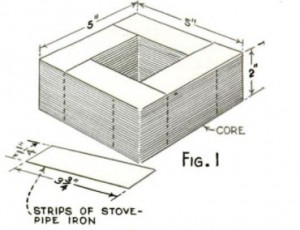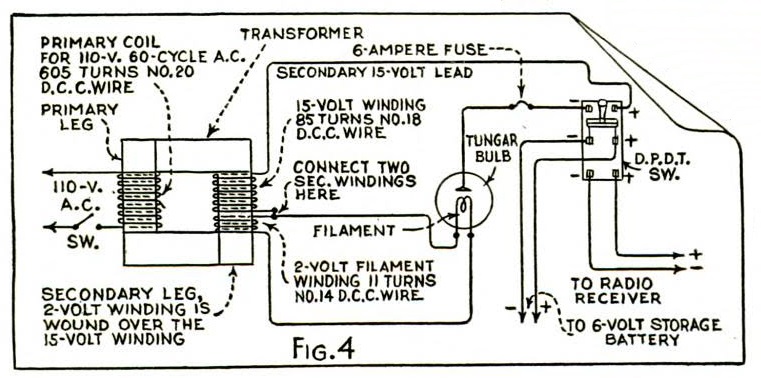 The plans for this battery charger appeared in Popular Mechanics 75 years ago this month, October 1942.
The plans for this battery charger appeared in Popular Mechanics 75 years ago this month, October 1942.
The project had a decidedly wartime angle: “Should it become necessary to store your car, this tungar battery charger will keep a 6-volt storage battery fully charged so that you can operate your auto radio indoors. This is only one of many timely civilian defense uses for an efficient and inexpensive battery charger.”
The only electronic part necessary to construct the charger was a GE tungar bulb. The “tungar” name for this type of rectifier came from the fact that it contained a tungsten filament and the bulb was filed with argon gas. The bulb specified by the project had a two-volt filament, and screwed into a standard lightbulb socket, with a separate lead running to the anode. The whole charger was mounted on a wooden board. The article specified that it should not be enclosed, in order to allow ventilation. Thus, the 110 volt terminals were left exposed.
 The transformer was also homemade. The core consisted of strips of stovepipe iron, carefully cut and shellacked together as shown here. Wood from a cigar box was used as a form to construct the core. The windings went over a layer of electrical tape, with the secondary winding also containing a layer of “empire cloth, available from electric shops.” The iron laminates were clamped together with hardwood or bakelite, bolted together firmly to keep the transformer from humming. The instructions called for the cord to be placed in a “moderate oven” and baked until dry.
The transformer was also homemade. The core consisted of strips of stovepipe iron, carefully cut and shellacked together as shown here. Wood from a cigar box was used as a form to construct the core. The windings went over a layer of electrical tape, with the secondary winding also containing a layer of “empire cloth, available from electric shops.” The iron laminates were clamped together with hardwood or bakelite, bolted together firmly to keep the transformer from humming. The instructions called for the cord to be placed in a “moderate oven” and baked until dry.
The windings in the article were made with wire from a burnt out transformer. The primary consisted of 605 turns, with a coat of shellac after each layer. The secondary had 85 turns to supply 15 volts to the rectifier, with another 11 turns to provide the 2 volts for the filament. Finally, a knife switch was connected to the battery, to be flipped one way to charge, and the other way to play the radio.

